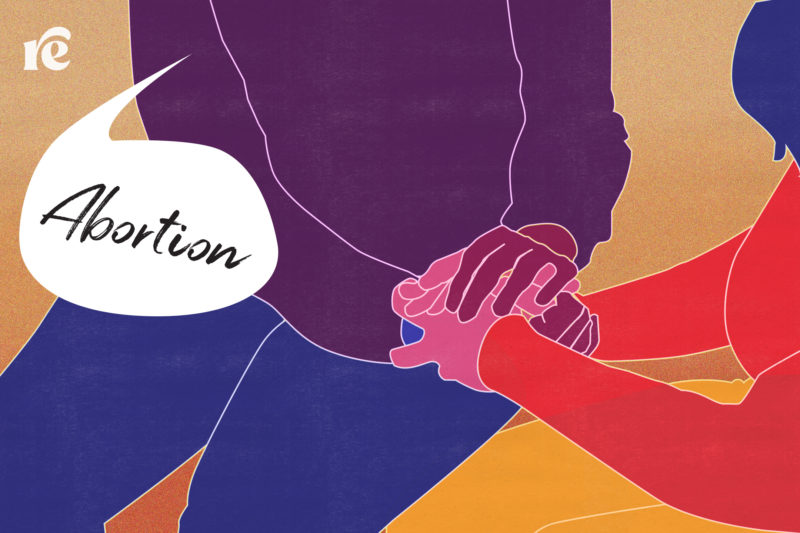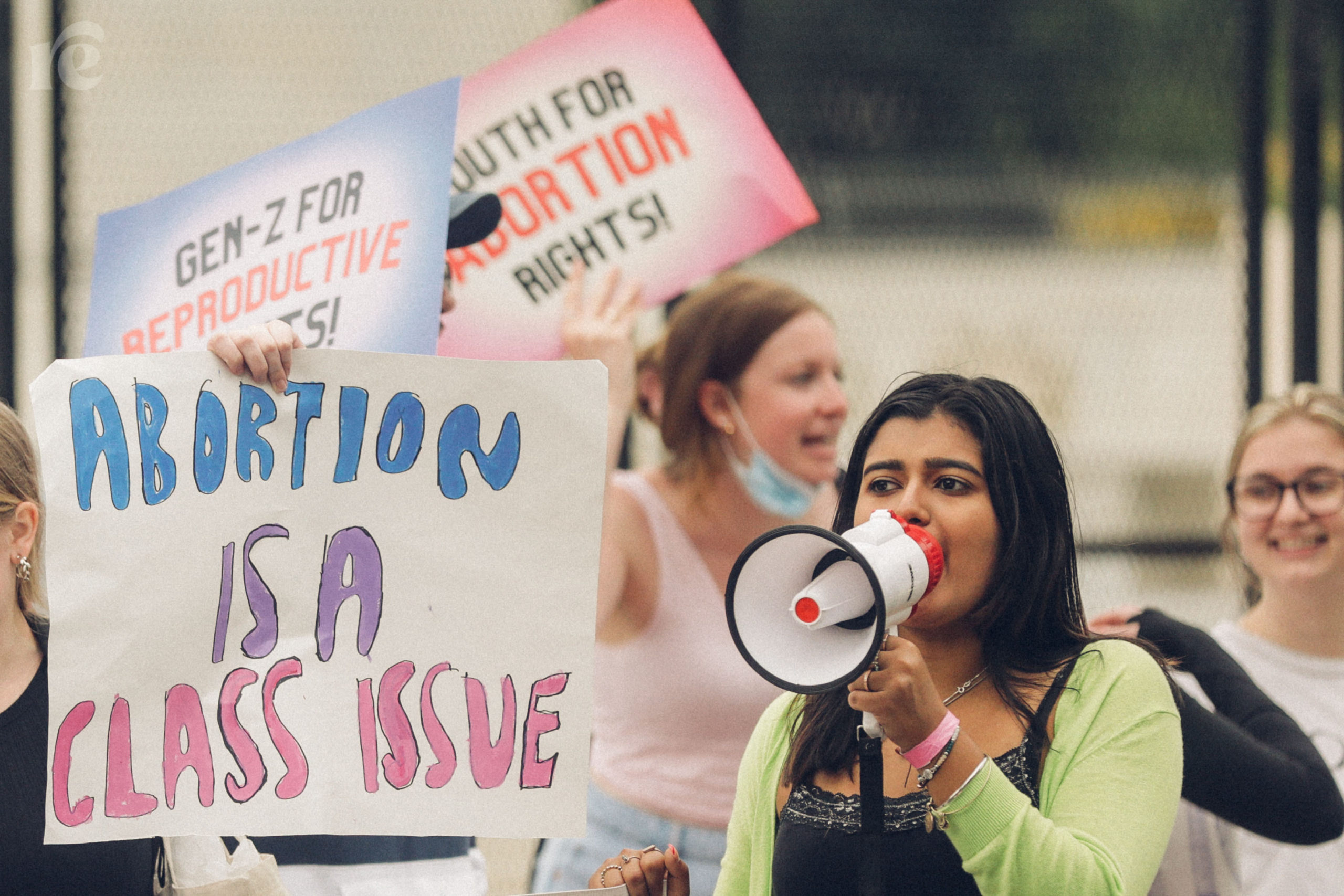Why I Became an Abortion Doula During the Pandemic
After being isolated and lonely when I became pregnant in March 2020, I now help others so they feel less alone.

In March 2020, at the beginning of the pandemic, I realized I might be pregnant. My uterus felt heavy. My period was only two days late, but something felt off. I was alone and didn’t have a ride, so I called an Uber to the nearest grocery store to buy a pregnancy test. When I got home, I hurried to the bathroom and took the test. It was positive.
All of that was already a costly decision. I had set aside money for my bills and groceries that month, and as a full-time student and Medicaid recipient, I didn’t have the financial resources to pay for an abortion. In fact, the cost of a first-trimester abortion in the state of Ohio, where I live, was more than one month’s rent for my apartment. Luckily, I received financial assistance from the Abortion Fund of Ohio.
The isolation and loneliness I felt during my abortion made me decide to become an abortion doula and help others. I had already been doing the work—like consoling folks before abortion appointments, researching nearby clinics, and sharing information about local abortion funds. I had hoped to receive more training, but as the state of abortion access continued to erode nationwide, I found myself providing emotional support to friends, acquaintances, and strangers.
My favorite part of my work is when people tell me about the abortions they’ve already had or about the ones they want or need. It made me realize there’s significance and meaning in being someone who is loud and proud about the abortions I’ve had. I tell my story so that others getting an abortion know they are not alone.
For young people by young people
Last March, a few months before the Supreme Court overturned the constitutional right to abortion, five fellow youth activists at Advocates for Youth and I helped develop a six-week abortion doula course by and for young people, as we knew that young people would continue to be affected by abortion bans and restrictions once Roe v. Wade fell.
More than 100 Youth Abortion Support Collective members gained physical, emotional, and informational support skills to support young people before, during, and after an abortion experience, like building their own abortion doula collectives on their high school and college campuses. Though 2022 may go down in history as the worst year on record for attacks on bodily autonomy, I am really proud of the work done in the face of such grievous circumstances.
View this post on Instagram
Young people are also picking up the pieces on college campuses and online communities alike and addressing the barriers that exist when we access abortion care. Just in the past year, organizers on college campuses have demanded—and won—access to medication abortion at campus health centers to ensure students living on campus without the ability to travel to or pay for an abortion at a clinic are able to receive the care they need.
In July, five weeks after Roe was overturned, Massachusetts Gov. Charlie Baker signed HB 5090, which made the state the second in the nation (behind California) to require public colleges and universities to offer medication abortion at their health centers.
The fight to bring medication abortion to campuses isn’t stopping there. After two years of pressuring their college to do so, a group of Barnard College students who co-founded the Reproductive Justice Collaborative successfully pressured college administrators to provide medication abortion on campus by the fall, becoming the first private college to do so. They are also taking part in a larger legislative campaign to ensure that medication abortion is available on publicly funded SUNY and CUNY campuses in New York through the passage of a statewide bill.
Living out reproductive justice values
On June 24, I woke up around 7 a.m. Pacific to my phone vibrating under my pillow. A text read “It’s overturned.” Without replying or reacting to the message, all I could do was use Google to confirm what happened. I closed my eyes and yelled aloud, “No fucking way,” and wanted to go back to bed immediately. But I knew it was going to be a long day.
It had already been a long year prepping for this very moment. The messages I received that day ranged from “We’ve been saying this would happen for how long?” to “Can they actually just take this away from us?” and “How can I get involved in whatever you’re doing? I want to help.” And while the sentiment was appreciated and I am always hoping that more people become involved in the fight for reproductive justice, at times it can be extremely exhausting to level with people’s sense of urgency in the face of massive events such as Texas SB 8, the abortion bounty hunter law, or the overturn of Roe when you already know that abortion is inaccessible nationwide. And has been for quite some time.
The three core values of reproductive justice are the right to have a child, the right to not have a child, and the right to parent children in safe and healthy environments. Reproductive justice is very personal to me as someone who has had adverse reproductive health-related experiences, belongs to exploited communities, and has had multiple abortions.
My experiences have taught me that the only path to inclusive, comprehensive, and accessible abortion care is organizing through the lens and framework of reproductive justice. I am able to see the value that having abortions has had on my life, and how abortion access, or the lack thereof, is at the heart of my experiences as well as those of my community.
To me, reproductive justice also means having access to reproductive health care. It means no one is criminalized for any pregnancy loss outcome including abortion, restricted, or discouraged from seeking reproductive health-care services. When I envision a world where reproductive justice is realized, some things that come to mind are: access to clean drinking water and air, quality and affordable education, childcare, housing, police abolition, and universal health care.

For marginalized communities, none of this is new
I often think about how my abortions and the reasons for which we mourn the fall of Roe signify a common issue: the need to liberate abortion. I want to create a world where our reproductive fates aren’t determined by how much money we have or where we live. I’ve been there. I’ve been met with the ridiculous barriers when accessing abortions in two completely different places both geographically and politically, and my experiences affirmed that Roe has never been enough. My hope is that we all protect abortion access and continue to fight to make sure everyone has access to abortion care at any time and for any reason.
In the aftermath of the overturn of Roe, there have been renewed conversations and attention focused on the impacts of banning and restricting abortion in certain states. These barriers and restrictions are not new. Low-income, undocumented, queer, and trans BIPOC folks have had to endure the brunt of sweeping bans and restrictions taking effect over the course of the almost 50 years that Roe was the law of the land.
I incorporate a reproductive justice framework into my work by seeking to address the forms of reproductive oppression that exist within my community, like forced sterilization and high Black maternal mortality rates, through my work as an advocate and doula. One of the primary aspects of my work is challenging folks to think and speak beyond “the right to choose” in regards to abortion and begin thinking about ways in which race, gender, sexuality, language barriers, class, and more also contribute to a lack of choices and access for exploited people in our communities. This framework also informs how I organize and interact with others in the work, knowing that the identities and experiences people hold impact how they show up.
The loss of Roe was absolutely devastating, but we now have the opportunity to create a future where access to abortion is fully liberated and not solely on the basis of a right to privacy.
Abortion should not be a word that we whisper in secret. It is about ensuring equity and autonomy for every person who can become pregnant. It is about reminding everyone that abortion is health care. We do not have to revert to back-alley abortions and forced pregnancies because we now have a very safe and effective method to terminate pregnancies: abortion pills.
The future I envision allows people to self-manage their abortion without fear of criminalization or imprisonment. Moving into a future beyond Roe is about remembering what we endured, how we organized, and the ways we will continue to advocate for access to abortion. Young people nationwide have been and will continue to lead that charge and the time for others to follow suit is long overdue.

